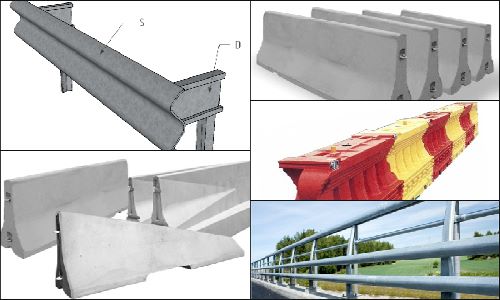Types of Crash Barriers: Choosing the Right Barrier for Your Needs
 By
By
As traffic and road infrastructures continue to grow, so does the need for enhanced safety measures. Among these safety components, crash barriers play a pivotal role. These are designed to prevent vehicles from leaving the roadway and hitting dangerous obstacles. But not all barriers are created equal. With a range of types available, it can be challenging to identify the one best suited to your specific needs.
As traffic and road infrastructures continue to grow, so does the need for enhanced safety measures. Among these safety components, crash barriers play a pivotal role. These are designed to prevent vehicles from leaving the roadway and hitting dangerous obstacles. But not all barriers are created equal. With a range of types available, it can be challenging to identify the one best suited to your specific needs.
Types of Crash Barriers
There are a number of crash barrier types available, so let’s have a deep dive into the different choices, and where they’re best applied:
There are a number of crash barrier types available, so let’s have a deep dive into the different choices, and where they’re best applied:
Metal Beam Crash Barriers
Metal beam crash barriers, often made from steel or aluminium, are designed to prevent vehicles from leaving the roadway. They are typically installed along highways, bridges, or around sharp corners. They are designed to flex upon impact, absorbing some of the crash energy and redirecting the vehicle back onto the road.
Metal beam crash barriers, often made from steel or aluminium, are designed to prevent vehicles from leaving the roadway. They are typically installed along highways, bridges, or around sharp corners. They are designed to flex upon impact, absorbing some of the crash energy and redirecting the vehicle back onto the road.
Concrete Barriers
Concrete barriers, also known as Jersey barriers, are sturdy and can resist heavy impacts. Their primary use is in separating lanes of traffic, especially during road construction. Due to their weight and stability, they are also effective in preventing vehicle crossover in high-risk areas.
Concrete barriers, also known as Jersey barriers, are sturdy and can resist heavy impacts. Their primary use is in separating lanes of traffic, especially during road construction. Due to their weight and stability, they are also effective in preventing vehicle crossover in high-risk areas.
Cable Barriers
Cable barriers, also known as wire rope safety barriers (WRSB), offer high levels of flexibility. Consisting of multiple steel wire ropes mounted on weak posts, these barriers absorb impact energy effectively and can deflect vehicles back onto the road.
Cable barriers, also known as wire rope safety barriers (WRSB), offer high levels of flexibility. Consisting of multiple steel wire ropes mounted on weak posts, these barriers absorb impact energy effectively and can deflect vehicles back onto the road.
Wire Rope Barriers
Wire rope barriers are flexible barrier systems that use high-tension wire ropes supported by steel posts. Upon impact, they can stretch and absorb the energy of the crash, reducing the severity of the collision. These barriers can "catch" vehicles and prevent them from crossing into oncoming traffic or off the road entirely.
Wire rope barriers are flexible barrier systems that use high-tension wire ropes supported by steel posts. Upon impact, they can stretch and absorb the energy of the crash, reducing the severity of the collision. These barriers can "catch" vehicles and prevent them from crossing into oncoming traffic or off the road entirely.
Roller Barriers
A recent innovation in the field, roller barriers consist of rolling cylinders placed on a rail. Upon impact, these cylinders rotate to convert shock into rotational energy, reducing the impact force and helping to redirect the vehicle along the barrier line.
A recent innovation in the field, roller barriers consist of rolling cylinders placed on a rail. Upon impact, these cylinders rotate to convert shock into rotational energy, reducing the impact force and helping to redirect the vehicle along the barrier line.
Choosing the Right Barrier
Selecting the right crash barrier depends on the specific conditions of the area where it will be installed. Consider factors such as vehicle speed, the volume of traffic, and the type of vehicles that frequent the road.
Metal beam crash barriers are versatile and suitable for most roads. They can handle impacts from different angles, making them ideal for roads with sharp turns.
Concrete barriers are suited to areas with heavy traffic where there's a high risk of head-on collisions. Their robust structure makes them ideal for construction zones and highway median separations.
Cable barriers are an economical option and work well in areas with wide medians that can accommodate the large deflection space these barriers require.
Lastly, roller barriers are excellent for high-speed areas as they effectively minimise the risk of a vehicle overturning or being significantly damaged.
Selecting the right crash barrier depends on the specific conditions of the area where it will be installed. Consider factors such as vehicle speed, the volume of traffic, and the type of vehicles that frequent the road. Metal beam crash barriers are versatile and suitable for most roads. They can handle impacts from different angles, making them ideal for roads with sharp turns. Concrete barriers are suited to areas with heavy traffic where there's a high risk of head-on collisions. Their robust structure makes them ideal for construction zones and highway median separations. Cable barriers are an economical option and work well in areas with wide medians that can accommodate the large deflection space these barriers require. Lastly, roller barriers are excellent for high-speed areas as they effectively minimise the risk of a vehicle overturning or being significantly damaged.
Conclusion
Choosing the right crash barrier is a decision of paramount importance. It not only ensures the safety of the people on the road but also significantly impacts the overall flow of traffic. Understanding the pros and cons of each type of crash barrier and evaluating the specific requirements of your area will enable you to make the best choice.
Choosing the right crash barrier is a decision of paramount importance. It not only ensures the safety of the people on the road but also significantly impacts the overall flow of traffic. Understanding the pros and cons of each type of crash barrier and evaluating the specific requirements of your area will enable you to make the best choice.
FAQs
We’ve put together some of the most frequently asked questions, which will hopefully answer any queries that you may have:
We’ve put together some of the most frequently asked questions, which will hopefully answer any queries that you may have:
What are crash barriers made with?
Crash barriers can be made from different materials, including steel, concrete, and cable. The type of material used typically depends on the desired strength and flexibility of the barrier.
Crash barriers can be made from different materials, including steel, concrete, and cable. The type of material used typically depends on the desired strength and flexibility of the barrier.
Can crash barriers be used in pedestrian areas?
Yes, pedestrian safety barriers are designed to protect pedestrians from vehicle intrusion. They are usually shorter and less heavy-duty than roadway crash barriers.
Yes, pedestrian safety barriers are designed to protect pedestrians from vehicle intrusion. They are usually shorter and less heavy-duty than roadway crash barriers.
How are crash barriers installed?
Crash barrier installation methods vary based on the type of barrier and the specific site conditions. Generally, they are either bolted or anchored into the ground.
Crash barrier installation methods vary based on the type of barrier and the specific site conditions. Generally, they are either bolted or anchored into the ground.
Are there any environmental considerations when installing crash barriers?
Absolutely. Some crash barrier systems are more environmentally friendly than others. For example, cable barriers can be more eco-friendly as they use less material, cause less damage when hit, and are easily repairable.
Absolutely. Some crash barrier systems are more environmentally friendly than others. For example, cable barriers can be more eco-friendly as they use less material, cause less damage when hit, and are easily repairable.
How frequently should crash barriers be inspected?
Regular inspection of crash barriers is essential for maintaining their functionality. The frequency depends on the type of barrier and the traffic conditions, but at least once a year is a good rule of thumb.
Regular inspection of crash barriers is essential for maintaining their functionality. The frequency depends on the type of barrier and the traffic conditions, but at least once a year is a good rule of thumb.
How are crash barriers tested?
Crash barriers are tested according to safety standards and regulations that measure their performance during simulated crash events. These tests examine factors like the barrier's ability to contain and redirect vehicles, the level of damage inflicted on the vehicle, and the likely injury risk to occupants. Testing standards can vary by country and region.
Crash barriers are tested according to safety standards and regulations that measure their performance during simulated crash events. These tests examine factors like the barrier's ability to contain and redirect vehicles, the level of damage inflicted on the vehicle, and the likely injury risk to occupants. Testing standards can vary by country and region.
Are crash barriers always effective?
While crash barriers are designed to improve road safety, their effectiveness can depend on many factors, such as the type and speed of the vehicle, the angle of impact, and the specific design and installation of the barrier itself. They can significantly reduce the risk of severe injuries and fatalities in many crash scenarios, but they cannot prevent all potential crash outcomes.
While crash barriers are designed to improve road safety, their effectiveness can depend on many factors, such as the type and speed of the vehicle, the angle of impact, and the specific design and installation of the barrier itself. They can significantly reduce the risk of severe injuries and fatalities in many crash scenarios, but they cannot prevent all potential crash outcomes.
How are the locations of crash barriers decided?
The placement of crash barriers is determined by various factors including the road layout, traffic volume, the presence of pedestrians or cyclists, the type and speed of vehicles using the road, the proximity of hazards or obstacles, and more. Engineers and traffic safety experts analyse these factors to determine the most effective locations for barrier installation.
The placement of crash barriers is determined by various factors including the road layout, traffic volume, the presence of pedestrians or cyclists, the type and speed of vehicles using the road, the proximity of hazards or obstacles, and more. Engineers and traffic safety experts analyse these factors to determine the most effective locations for barrier installation.
Where can I find the best crash barriers in the UK?
There are several companies in the UK that manufacture and supply high-quality crash barriers. Here are a few you could consider:
Hill & Smith Ltd: They are specialists in the manufacture of highway safety barriers, and their products are designed and tested to comply with international road safety standards.
Berry Systems: Berry Systems offers a wide range of vehicle safety barriers for car parks, warehouses, and loading bays, among other applications.
Maltaward: They provide a range of concrete barriers for traffic management, site security, and other uses.
Safetyflex Barriers: Safetyflex Barriers is a global leader in anti-terrorism security barriers, bollards, and fences.
Alternatively, just type in Armco Barriers UK, in Google, where you’ll be sure to find a barrier company offering quality crash barriers suited to your needs.
Remember to do your own research and reach out to these companies to understand their products better and see which one meets your specific requirements. Consider factors such as durability, compliance with safety standards, the reputation of the company, and customer reviews.
There are several companies in the UK that manufacture and supply high-quality crash barriers. Here are a few you could consider: Hill & Smith Ltd: They are specialists in the manufacture of highway safety barriers, and their products are designed and tested to comply with international road safety standards. Berry Systems: Berry Systems offers a wide range of vehicle safety barriers for car parks, warehouses, and loading bays, among other applications. Maltaward: They provide a range of concrete barriers for traffic management, site security, and other uses. Safetyflex Barriers: Safetyflex Barriers is a global leader in anti-terrorism security barriers, bollards, and fences. Alternatively, just type in Armco Barriers UK, in Google, where you’ll be sure to find a barrier company offering quality crash barriers suited to your needs. Remember to do your own research and reach out to these companies to understand their products better and see which one meets your specific requirements. Consider factors such as durability, compliance with safety standards, the reputation of the company, and customer reviews.




